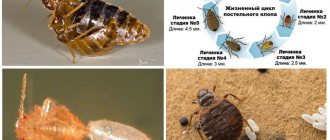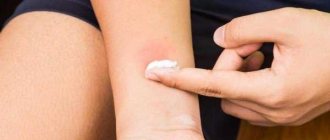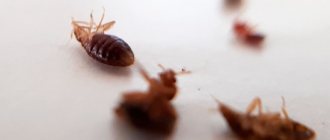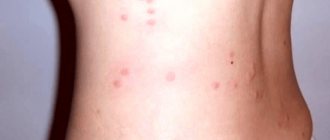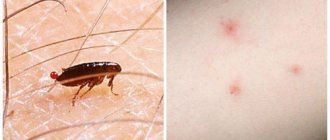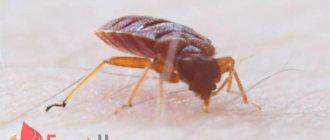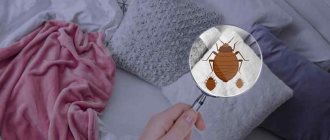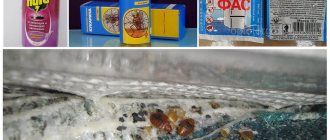If you have even the slightest suspicion that someone unwanted is “sleeping” in your bed with you, immediately begin to act: check the mattress, pillowcase, joints of the mattress and the bed frame. If bed bugs are not visually noticeable, this does not mean that they are not there; they prefer to hide well. Examine your body in front of the mirror for bites; if they are present, most likely you have bedbugs in your bed.
In this article, we will explore in detail why bedbugs appear in a mattress and whether they can live inside a mattress, as well as how to get rid of bedbugs in a mattress yourself without the help of an exterminator.
Where did bedbugs come from in the mattress?
The appearance of parasites in your bed can come as a complete surprise if you keep your apartment clean. So where do bedbugs come from and can they settle in a completely new mattress from the store?
In the photo: bedbugs in a mattress, old and new. Traces of their vital activity are visible; dark spots are bedbug excrement.
We list the main ways a bedbug can enter a house:
- ventilation system - through it insects move freely from one apartment to another;
- windows - in the warm season, bedbugs can move from the basement or neighboring apartment directly along the walls and enter your home through the window;
- guests - they can, without knowing it, bring parasites with them;
- hotels, hostels - by staying in unverified places on a trip, you risk bringing bedbugs home in a suitcase with clothes;
- workers - if they are doing repairs at your place, they may have brought bloodsuckers from the previous repair site;
- shops - from a furniture store you can bring new furniture or a mattress already infested with bedbugs into your apartment, because the warehouses in which goods are stored are not sparklingly clean.
Prevention
There is no 100% protection against bedbugs in your home. Maintaining cleanliness and order in the apartment will help to detect their appearance in a timely manner and avoid further spread.
Prevention measures:
- Washing bed linen at maximum temperature followed by ironing.
- At least twice a year, the mattress is turned over and inspected. If a trail of feces or remains of chitinous shells is detected, they immediately begin to bait the bedbugs.
- Upon returning from vacation, travel bags are checked for parasites. As a preventive measure, suitcases are treated with steam.
- Periodically check and install new sockets.
- Cracks and crevices are sealed with sealant.
- They are making cosmetic repairs to the apartment - gluing up wallpaper and baseboards.
- Periodically inspect chairs, sofas, and cabinets for the presence of bedbugs.
Advice! When inspecting, use a flashlight and a magnifying glass.
- Parasites love to settle under parquet floors, and it is almost impossible to get them out of there. Therefore, do not use this material as a floor covering.
- Used items and furniture should be washed, ironed, steamed, and dry-cleaned.
- If there are a large number of books, they are periodically inspected.
- Check the back and back walls of the bedside tables, having first removed all things from them.
- When staying at a hotel, they check the mattress and bed. If there is any doubt about the presence of parasites, personal items are packed in sealed bags.
- When returning from guests who have bedbugs, wash bags and clothes and wash shoes.
- Purchase a special removable sealed cover for the mattress, which will prevent the spread of parasites.
- Before moving into a new apartment, carry out pest control.
- Use bait and traps. For example, wrap the legs of a bed with duct tape and place traps on four sides.
Barrier protective treatment is an effective way to limit the entry of parasites from other apartments. Invisible fat capsules are applied throughout the room using a fog generator or manual irrigation. Upon contact with an insect, the substance covers its chitinous shell, preventing further reproduction.
There are bedbugs in the mattress - how to find them?
In fact, finding bedbugs in a bed or mattress is not such an easy task, because they are very small in size and crawl into a variety of crevices and inside the mattress through the seams. But there are many signs by which you can recognize the presence of uninvited guests. For example, smell. If you sniff the mattress, you can smell an unpleasant, pungent odor, similar to the smell of cognac or fermented raspberries.
Carefully examine the surface, in particular the seams. And if you find translucent or light-colored husks there, it will most likely turn out to be scales of parasites that fell off during molting. When yellowish spots are found on a white mattress, this is also a reason to believe that bedbugs live in the mattress. If someone is crawling on you at night, and in the morning reddish spots are found on your skin, this is a clear sign of their presence. Bedbugs can also be detected using their own waste; dark-colored feces are easily visible on white bedding.
Let's summarize: what are the signs of bedbugs in a mattress?
- bite marks;
- unpleasant odor;
- brown spots on bed linen from crushed bedbugs;
- bedbug feces - small “poppy” brown or black grains in the bed;
- chitinous shells shed by larvae.
Parasite identification
Appearance of a bedbug It is not difficult to recognize bedbugs and distinguish them from other types of blood-sucking insects. The parasite has a characteristic structure and appearance:
- strongly flattened body - thanks to this geometry, hungry individuals are protected from mechanical stress and are able to crawl through the smallest holes and cracks;
- on the head there is a proboscis with 2 channels, through one an anesthetic enzyme is introduced during a bite, through the second blood is drawn in;
- Domestic bugs do not have wings, they cannot fly, but they have well-developed legs; adult pests move quite quickly on dry surfaces and cover 1 meter per minute, the larvae are slower - their result is 25 cm per minute;
- bed guests do not like wet surfaces, this is due to the fact that they are afraid to wet their abdomen and move slowly and carefully.
What a bedbug looks like depends on how infested it is. An individual that ate a few days ago may be almost black in color; very hungry parasites have a dirty yellow color. Pests have their original color immediately after a meal. Their color becomes bright scarlet. The size of the bug also depends on satiety.
Interesting!
Mattress bugs feed rarely at intervals of 7-10 days, but they gorge themselves for future use. The diet of parasites consists exclusively of blood. In one session, an adult absorbs blood, the weight of which is 2 times the weight of the insect itself. The size of the pest increases to 8 mm, it becomes clumsy, moves with difficulty and is often crushed in the bed as a result of random human movements.
How and with what to treat a mattress against bedbugs?
First of all, you need to remove the bed linen from the mattress and wash it well at high temperature and steam or iron it.
The next step is to remove the mattress from the bed frame. To prevent the spread of parasites, carpets or other things located near the bed must be removed.
After the area is cleared, we begin to examine the mattress. We pull it out from the base, turn it over on its edge and examine it from all sides. Most likely, signs of bedbugs will be detected instantly. If they are not visible on the outside, look inside the mattress; perhaps this is where bedbugs live and breed.
If the covering is removable, then remove and wash it, then steam it thoroughly with a home steamer or hang it to dry in the sun. Treat the insides of the mattress with an insecticide against bedbugs; Xulat Micro or any other effective preparation is suitable for this. If the casing cannot be removed, begin processing immediately, but be sure to follow the manufacturer’s instructions and take safety precautions! Treat the entire area of the room, especially furniture located next to the bed, baseboards, corners and hard-to-reach places.
At the next stage, you need to disassemble the sleeping area and provide access to all hard-to-reach areas in order to destroy the parasites that have settled in them with a bedbug repellent. If the mattress is more than 5 years old, it would be better to throw it out and buy a new one, this way you will get rid of bed dust mites and allergies to them.
How to treat a mattress to get rid of bedbugs?
We have already briefly described how to independently treat a room from bed bugs, now we will discuss what other ways there are to get rid of bed bugs in a mattress. There are four main ways:
- freezing;
- heat treatment;
- contacting a specialized company;
- self-removal of bedbugs using chemicals.
Let's consider the first method - cooling. In winter there is nothing complicated about it, since insects die from a temperature of -20C in about a day. Take your mattress out into the yard and leave it for two days. And when you bring it in, don’t forget to shake it off. This method is effective, but not 100%, since some of the bloodsuckers remain in the house, behind baseboards and in other secluded places.
Let's move on to the second method - exposure to hot air or steam. To do this, you need to thoroughly treat the mattress with a steamer or steam generator on all sides, without missing seams and joints. The method, like the previous one, has disadvantages.
You can seek help from a specialized company or city SES. They can be found in almost any city, all newspapers are full of such advertisements, and there are even more offers on the Internet. Do not be fooled by the low cost of the procedure; most likely, cheap treatment will be carried out with low-quality drugs that will not completely eliminate the problem. The average cost of services of a professional exterminator in Moscow is 2-3 thousand rubles.
Specialized chemicals, of which there are plenty on sale, will also help in getting rid of bloodsuckers. They differ in chemical composition and cost. It is better to buy new drugs rather than old ones that were used 10 years ago. Insects adapt to chemistry and become immune to it.
Modern insecticides have a complex composition and cost a lot - from 500 rubles. If there are children or pets in the house, be sure to take this into account when choosing a poison, choose a less toxic one, or take them away from the house during treatment.
There are also mechanical and manual methods of exterminating bedbugs, these are: crushing, destroying nests, sucking with a vacuum cleaner. These are very dubious methods that do not provide any guarantees.
Traces on the human body
So what traces do bedbugs leave on the human body? According to doctors, after an insect bite, a red bump remains at the site of penetration. It is very itchy, swollen, and painful.
Therefore, a large red spot makes people think that mosquitoes have settled in the house. Residents begin to actively fight flying bloodsuckers, while bedbugs continue to increase their population.
In some people, bedbug bites cause an allergic reaction, then it is difficult to correctly differentiate a harmless wound . After insects, red spots resemble bumps, but not pimples.
The swellings are very painful, itchy, and inflamed. If you scratch the penetration site, there is a risk of infection, which complicates treatment.
When pests settle, the number of bites gradually increases, being located chaotically on the body in places accessible to penetration. The allergy covers areas of the skin completely, it is smaller and is localized not only in open areas of the body.
Bites
To understand that it is a bug that bites and not another insect, it is worth examining the wound. Bloodsuckers leave a kind of trail. They produce 2-5 bites about 5-10mm apart. After drinking a sufficient amount of blood, the insects retreat to their nest.
Bedbugs attack in colonies, so in the morning there may be several grooves, but all of them are located only on open areas of the skin, since the pest is not able to bite through clothing. It also does not touch skin that is heavily covered with hair.
Parasites attack only at night, although if there is a large infestation, bloodsuckers can come out during the day. Adult bedbugs have a proboscis with two sections, through one they suck in blood, and through the other they inject a secretion that blocks nerve endings, which causes an analgesic effect. Thus, a person does not feel pain and notices the appearance of bite marks only in the morning.
Bloodsuckers love to attack children because they have delicate, thin skin that has no specific odors. The duration of the meal can be 15-20 minutes, during which time the bloodsucker receives 0.5-7 ml of blood.
Bedbugs do not attack every night; the dose of food they receive lasts for 5-7 days, after which they return to the victim. The female requires more frequent feeding to lay eggs.
Bedbugs drink human blood; parasites do not harm animals except for the lack of food.
Folk remedies that kill bedbugs
If there are few insects, folk remedies can help. In most cases, these methods help repel pests, but do not destroy them. Tansy and wormwood will help against bedbugs if you spread them throughout the apartment. Their smell is unpleasant to insects and they will try to leave such housing.
You can also help get rid of uninvited “guests”: solutions of turpentine, kerosene, naphthalene, salicylic acid, vinegar and many others. Their effectiveness is very low compared to chemical developments.
Features of parasitism and reproduction
Reproduction of a bed bug In comparison with house flies, the female of which lays up to 400 eggs in 4 days, the reproduction of bed bugs does not occur at such a rapid pace, but the size of the colony increases exponentially. Over the course of its entire life, a female lays no more than 500 eggs. She does this in doses: 5 pieces daily. According to observations, the female tries to hide the oviposition every time. Such foresight contributes to the safety of the population.
On a note!
Bedbug eggs are protected by a dense shell, which is well fixed to both horizontal and vertical surfaces. In addition, almost no insecticide is capable of destroying it. This is why poison manufacturers insist on re-processing.
With good vision, bedbug eggs are clearly visible. Their size is slightly less than a millimeter and they are oblong white capsules resembling grains of rice. Within a week, larvae (nymphs) emerge from the eggs; they are distinguished from adults only by their size. As they grow, nymphs molt, and their chitinous shells can often be found on a mattress, floor, or bed. A month after hatching from the egg, the larva becomes a sexually mature individual, ready to reproduce. The ratio of both sexes in the colony is the same, so there are no difficulties with mating.
Safety precautions for chemical processing
Due to the use of chemicals to remove insects, the following safety precautions must be followed:
- Always wear rubber gloves and a gauze bandage before starting treatment.
- Work in closed clothes. Be sure to cover your head with a thick scarf or other headdress.
- After completing the treatment, be sure to wash your hands and face well with soap, change clothes and go outside for several hours so that the drug has time to take effect.
- Ventilate the room.
